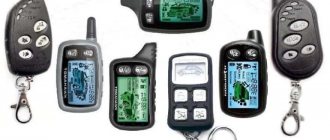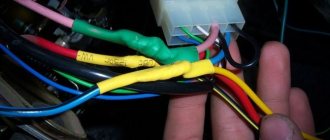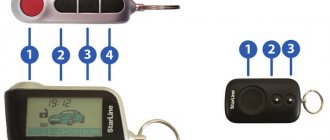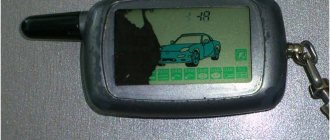Alligator car alarms are the development of an American company that first entered the market in 1997. For the Russian market, models are assembled in Taiwan.
Aligator c-300
The company offers some of the best security systems with:
- one-way and two-way communication;
- GPS and GSM module;
- multifunctional keychain;
- encodings that are not accessible to code grabbers;
- increased range.
Characteristics of “C” series car alarm models
| Specifications | Model | |||
| Alligator C-3C | Alligator C-2C | Alligator C-500 | Alligator C-300 | |
| Type and number of key fobs | 2 pcs. with LCD display and without display | 2 pcs. with LCD display and without display | 2 pcs. with LCD display and without display | 2 pcs. with LCD display and without display |
| Countdown timer in two-way key fob | Eat | Eat | Eat | Eat |
| SLAVE mode (control of the car's standard key fob when using a CAN connection) | Depends on the vehicle configuration | Depends on the vehicle configuration | Depends on the vehicle configuration | No |
| Remote engine start/stop from key fob | Eat | No | Eat | Eat |
| Algorithms for protecting the radio channel between the key fob and the car | Improved BACS, enhanced anti-eavesdropping and anti-scanning code | Improved BACS, enhanced anti-eavesdropping and anti-scanning code | BACS Dialog, Bilarm Advanced Code System, dialogue code with maximum protection against interception and scanning | Improved BACS, enhanced anti-eavesdropping and anti-scanning code |
| Operating range in control/notification mode, m | 600/1200 | 600/1200 | 1500/2500 | 600/1200 |
| Frequency range, MHz | 434 | 434 | 868 | 434 |
| Anti-robbery function | Eat | Eat | Eat | Eat |
| Car owner call function | Eat | Eat | Eat | Eat |
| Car search function | Eat | Eat | Eat | Eat |
| Comfort function | Eat | Eat | Eat | Eat |
| Panic Mode | Eat | Eat | Eat | Eat |
| Valet service mode | Eat | Eat | Eat | Eat |
| Automatic programmable timed engine start at specified time intervals | Eat | No | Eat | Eat |
| Automatic programmable engine start at a preset time | Eat | No | Eat | Eat |
| Automatic programmable engine start based on temperature | Eat | No | Eat | Eat |
| Outputs for additional engine blocking (power) | 1 | 1 | 1 | 1 |
| Output of the 2nd radio-controlled channel for controlling the trunk lock or additional devices | Eat | Eat | Eat | Eat |
| 3.4 radio-controlled channel output for controlling additional devices | 2 | 1 | 2 | 2 |
| Interface for connecting to a computer for programming and system settings (Bilarm PC KIT Pro) | Eat | Eat | Eat | No |
| Interface for connecting a GSM module | Eat | Eat | Eat | No |
| Possibility of connecting a CAN module | Eat | Eat | Eat | No |
| FLEX channels with programmability | Eat | No | — | No |
| Turbo timer | Eat | Eat | Eat | Eat |
| Self-diagnosis when turning on the security mode | Eat | Eat | Eat | Eat |
| Possibility of installation on vehicles equipped with a Start-Stop button | Eat | Eat | Eat | Eat |
| Number of independent security zones | 6 | 5 | 6 | 6 |
| Silent arming/disarming of the system | Eat | Eat | Eat | Eat |
| Possibility of zone-by-zone disabling of system sensors | Eat | Eat | Eat | Eat |
| Bypassing a faulty zone when arming by specifying a zone or trigger | Eat | Eat | Eat | Eat |
| Automatic locking/unlocking of doors when the ignition is turned on/off | Eat | Eat | Eat | Eat |
| Disabling security in 2 stages | Eat | Eat | Eat | Eat |
| Memory for 1 or 2 last system triggers indicating zone/trigger | 2 | 1 | 2 | 2 |
| Remote start control input | Eat | No | Eat | Eat |
| Ability to start the engine in vehicles equipped with a Start-Stop button | Eat | No | Eat | Eat |
| Compatible with automatic and manual transmission | Eat | Eat | Eat | Eat |
| Passive engine blocking/immobilizer mode | Eat | Eat | Eat | Eat |
| Programmable engine run time | Eat | No | Eat | Eat |
| The ability to quickly diagnose the causes of automatic engine shutdown | Eat | No | Eat | Eat |
| Monitoring engine operation using a tachometer | Eat | No | Eat | Eat |
| Arming the system with the engine idling | Eat | Eat | Eat | Eat |
| Monitoring engine operation using an oil pressure lamp | Eat | No | Eat | Eat |
| Notification when the preheater is turned on | Eat | Eat | Eat | Eat |
| Preheater control | Eat | Eat | Eat | Eat |
Standard and extended set of options
The number of security zones, each of which operates independently or is connected. It is recommended to install an Alligator car alarm with 4-6 independent control points. If an attacker turns off 1-2 security zones, this will not reduce the level of protection of the machine. Key fob functionality – budget models are equipped with an on/off button. In security systems that fall into the middle and high price ranges, the key fob is equipped with an LED screen that displays operating parameters. List of other options:
- Emergency shutdown - in the event of an accident or disturbance in the stability of the electrical circuit, the alarm operates unstable. The presence of a service key on the key fob allows you to quickly render the system inoperative. The driver enters the PIN code previously recorded in the settings.
- Range of action – it all depends on the chosen modification. The indicator ranges from 1 to 2.5 km.
- Main frequency range – data transfer between the system and the key fob occurs in a certain range. The authorized sales center will tell you which frequency is least susceptible to hacking in the region.
- Protection against forcible seizure (anti-hijack) - a special button on the key fob remotely blocks the power unit if an attacker is already inside the car.
- Additional defense mechanisms - a criminal genius is constantly finding new ways to take over other people's cars. Developers representatives have an immobilizer option. If a criminal breaks into the cabin and tries to start the engine, the Alligator premium car alarm will block the power unit.
The functional alligator alarm system is equipped with a key fob that prevents accidental pressing of buttons. In the description, the manufacturer indicates that the locking option is included in the kit. Protection against electronic radiation used to hack a machine is provided by a digital or built-in relay. Information about its availability is available in the operating instructions. Branded alarm system for Alligator cars includes a number of other features:
- “comfort” – the ability to connect a sunroof closer, an electric window lift;
- “saving” – the key fob reduces battery consumption;
- “informing” – key fobs of premium modifications of the protective system display information about engine t;
- “ICE protection” – reduces the wear rate of the diesel engine;
- “timer” – turns on the engine in a given time period;
- “search” – the driver will quickly find the car that he left in a large parking lot;
- “Additional support” – a built-in additional power source reduces the likelihood of losing control of the alarm in the event of a low battery.
There is no limit for further perfection. The developed Alligator mid-range car alarm is equipped with additional outputs that are needed to connect new protective units.
On a note!
In the instructions, the manufacturer indicates that the system is equipped with the option of connecting at least 2 additional communication channels. If there is no such mark, then new protective blocks cannot be installed.
"A" series car alarms
| Specifications | Models | ||
| Alligator A-9 | Alligator A-1S | Alligator A-3S | |
| Key rings included | 2 pcs. with LCD display and without display | 2 pcs. 3-button | 2 pcs. 3-button |
| Operating range in control/notification mode, m | 600/1200 | 50 (control mode only) | 50 (control mode only) |
| Frequency range, MHz | 434 | 434 | 434 |
| Countdown timer in two-way key fob | Eat | No | No |
| 8192-channel ultra-narrowband FM radio path | Eat | No | No |
| Algorithms for protecting the radio channel between the key fob and the car | Dialog code with absolute protection against interception and scanning (Double dialog) | BACS II, dynamic code with enhanced protection against interception and scanning | BACS II, dynamic code with enhanced protection against interception and scanning |
| Record system performance (response time 0.25 sec) | Eat | Eat | Eat |
| Valet service mode | Eat | Eat | Eat |
| Anti-robbery function | Eat | Eat | Eat |
| Possibility of zone-by-zone disabling of system sensors | Eat | Eat | Eat |
| Panic Mode | Eat | Eat | Eat |
| Silent arming/disarming of the system | Eat | Eat | Eat |
| Number of independent security zones | 7 | 6 | 6 |
| Output of the 2nd radio-controlled channel for controlling the trunk lock or additional devices | Eat | Eat | Eat |
| 3.4 radio-controlled channel output for controlling additional devices | 3 | No | 1 |
| Possibility of connecting an additional sensor | Eat | No | Eat |
| Outputs for additional engine blocking (power) | 2 | 1 | No |
| Self-diagnosis when turning on the security mode | Eat | Eat | Eat |
| Memory for 1 or 2 last system triggers indicating zone/trigger | 2 | 2 | 2 |
| Car owner call function | Eat | No | No |
| Remote temperature measurement in the car interior | Eat | No | No |
| Car search function | Eat | Eat | Eat |
| Bypassing a faulty zone when arming by specifying a zone or trigger | Eat | Eat | Eat |
| Automatic locking/unlocking of doors when the ignition is turned on/off | Eat | Eat | Eat |
| Possibility of installation on vehicles equipped with a Start-Stop button | Eat | Eat | Eat |
| Comfort function | Eat | Eat | Eat |
| Remote measurement of vehicle on-board voltage | Eat | No | No |
| SLAVE mode (control of the car's standard key fob when using a CAN connection) | Depends on the vehicle configuration | No | No |
| Disabling security in 2 stages | Eat | No | Eat |
| Compatible with automatic and manual transmission | Eat | Eat | Eat |
| Possibility of connecting a CAN module | Eat | No | No |
| Turbo timer | Eat | No | Eat |
| Notification when the preheater is turned on | Eat | No | No |
| Preheater control | Eat | Eat | Eat |
| Automatic programmable timed engine start at specified time intervals | Eat | No | No |
| Automatic programmable engine start when the on-board supply voltage drops | Eat | No | No |
| Automatic programmable engine start at a preset time | Eat | No | No |
| Automatic programmable engine start based on temperature | Eat | No | No |
| The ability to quickly diagnose the causes of automatic engine shutdown | Eat | No | No |
| Ability to start the engine in vehicles equipped with a Start-Stop button | Eat | No | No |
| Monitoring engine operation using a tachometer | Eat | No | No |
| Monitoring engine operation using an oil pressure lamp | Eat | No | No |
| Monitoring engine operation using on-board voltage | Eat | No | No |
| Remote engine start/stop from key fob | Eat | No | No |
| Programmable engine run time | Eat | No | No |
| Passive engine blocking mode/immobilizer | Eat | Eat | Eat |
| Arming the system with the engine idling | Eat | Eat | Eat |
| Remote start control input | Eat | No | No |
"S" series car alarms
| Specifications | Models | ||
| Alligator S-325 | Alligator S-350 | Alligator S-975RS | |
| Key rings included | 2 pcs. with and without LCD display, 3 and 4 buttons, programmable | 2 pcs. with and without LCD display, 3 and 4 buttons, programmable | 2 pcs. with and without LCD display, programmable |
| Operating range in control/notification mode, m | 100/500 | 100/500 | 1000/2000 |
| Sound and vibration notification | Eat | Eat | Eat |
| Indication of security zones on the screen | Eat | Eat | Eat |
| Algorithms for protecting the radio channel between the key fob and the car | Advanced dynamic code using Keeloq TM processor and protection against interception and scanning | Keeloq dynamic code | BACS, Bilarm Advanced Code System, dynamic code with maximum protection against scanning and interception |
| Valet service mode | Eat | Eat | Eat |
| Output for additional engine blocking | Additional relay required | Eat | Eat |
| Starter blocking with a normally open relay | Eat | Eat | |
| Anti-HiJack mode | Eat | Eat | Eat |
| Comfort mode | Eat | Eat | Eat |
| Remote control of locks with built-in relays | Eat | Eat | Eat |
| Output of the 2nd radio-controlled channel for controlling the trunk lock or additional devices | Eat | Eat | Eat |
| 3.4 radio-controlled channel output for controlling additional devices | Eat | Eat | Eat |
| Connector for connecting an additional 2-level sensor | Eat | Eat | Eat |
| Negative and positive door/hood/trunk trigger inputs | Eat | Eat | Eat |
| Programmable 1-digit personal system shutdown code | Eat | Eat | Eat |
| Silent arming and disarming of the system | Eat | Eat | Eat |
| Car owner call function | Eat | Eat | Eat |
| Car search function | Eat | Eat | Eat |
| Setting the system to security mode with separate disabling of sensor zones | Eat | Eat | Eat |
| Arming without using a transmitter | Eat | Eat | Eat |
| Panic Mode | Eat | Eat | Eat |
| Disabling the security mode in 2 stages | Eat | Eat | Eat |
| Number of independent security zones | 6 | 6 | 7 |
| Memory for the last 2 system triggers indicating the zone/trigger | Eat | Eat | Eat |
| Bypassing a faulty zone when arming with zone/trigger indication | Eat | Eat | Eat |
| Automatic locking and unlocking of doors when the ignition is turned on/off | Eat | Eat | Eat |
| FAPC anti-false alarm function | Eat | Eat | Eat |
| Passive engine blocking mode | Eat | Eat | Eat |
| Ability to protect a vehicle with the engine running | Eat | Eat | Eat |
| Remote car engine start | No | No | Eat |
| Programmable engine start | Eat | Eat | Eat |
| Passive security | Eat | Eat | Eat |
Keychain appearance
You can determine the Alligator model by the design of the keychain, for this:
- They visit the official website, view alarm models and compare them with their version of the device.
- They find a description of the Alligator model on the Internet and, comparing the types of keychains by external features, look for their own.
- They try to get acquainted with their alarm system by studying the instructions for models that are externally similar.
- Alligator key fob alarm models, which are similar in appearance, may be different in their design.
Having looked at the images of key fobs of various models, you can find out that at first they were produced with 2 buttons, without feedback and limited functionality. Then, with the addition of security system functions, key fobs were replaced by three-button remote controls. The Alligator alarm system belongs to the latest version model and is produced with a four-button remote control equipped with a display and feedback.
Models with buttons
Each series of Alligator security car alarms was produced with a design unique to this version of the model. Thus, the first devices were produced with two buttons, without feedback and with limited functions. The role of the buttons was to open and close the doors and open the trunk. Such an alarm system is inexpensive and belongs to the budget category.
With the increase in functionality, the appearance of the remote control also changed; a third button and an LED were added, while the functions of the buttons remained the same.
More advanced models of Alligator security alarm systems with expanded functionality and feedback are produced with a remote control equipped with a display with 4 buttons.
Remote controls with display
Almost all remote controls with 4 buttons are equipped with a display. But there are four-button remote controls without it, and they are equipped with a feedback function. The display is informative, displays all the functions of the security device, so autostart is displayed in the lower right corner of the screen.
In addition, remote controls of the same series can be interchangeable, for example, devices from the SP “family,” and modifications 30/40 of the same line can even recognize the alarm model if the key fob is of a similar design. But the remote controls of the latest, later series cannot be recognized by devices of earlier versions.
Signals coming from devices of a similar design can be easily read by a security car alarm installed on a car, provided that the communication range is within the limits, because Each remote control has its own range.
Key fobs with a display are available in versions with 5, 4 and even 3 buttons. Remote controls with a screen are available in the Alligator device only with feedback.
Identifying the alarm system using the key fob, especially if the company logo has been preserved, will not be a big problem. To identify the device, just visit the manufacturer’s official website.
Car alarms series "M"
| Specifications | Models | |
| AlligatorM-700 | AlligatorM-850 | |
| Key rings included | 2 pcs. with and without LCD display, 3 buttons, programmable up to 4 transmitters | 2 pcs. with and without LCD display, 3 buttons, programmable up to 4 transmitters |
| Operating range in control/notification mode, m | 30 | 50 |
| Algorithms for protecting the radio channel between the key fob and the car | Keeloq advanced dynamic code, protection against interception and scanning | Keeloq advanced dynamic code, protection against interception and scanning |
| Remote control of door locks using built-in relays | Eat | Eat |
| Immobilizer Mode | Eat | Eat |
| Anti-HiJack mode | Eat | Eat |
| Valet mode | Eat | Eat |
| Panic Mode | Eat | Eat |
| Comfort mode | Eat | Eat |
| Car search function | Eat | Eat |
| Silent mode | Eat | Eat |
| Passive arming | Eat | Eat |
| Disabling the alarm mode in 2 stages | Eat | Eat |
| Programmable personal system shutdown code | Eat | Eat |
| Silent arming and disarming of the system | Eat | Eat |
| Connector for connecting an additional 2-zone sensor | Eat | Eat |
| 2nd channel output for controlling the trunk lock or additional devices | Eat | Eat |
| 3rd channel output for controlling additional devices | Eat | Eat |
| Hood/Trunk Negative Trigger Input | Eat | Eat |
| Ability to control closing car windows | Eat | Eat |
| Separate zone shutdown | Eat | Eat |
| Shock sensor | 2-zone | Eat |
| Arming without using a transmitter | Eat | Eat |
| Starter lock | Eat | No |
| Connecting additional engine blocking | Eat | No |
| Engine lock | No | Eat |
| Number of independent security zones | 5 | 5 |
| Bypassing a faulty zone when arming with zone/trigger indication | Eat | Eat |
| Automatic locking and unlocking of doors when the ignition is turned on/off | Eat | Eat |
| Output of the 2nd radio-controlled channel for controlling the trunk lock or additional devices | Eat | Eat |
| 3.4 radio-controlled channel output for controlling additional devices | Eat | Eat |
| FAPC function | Eat | Eat |
| Possibility of reprogramming individual inputs/outputs | Eat | Eat |
| Ability to protect a vehicle with the engine running | Eat | Eat |
Car alarms of the “SP”, “TD” and “D” series
| Specifications | Models | ||
| AlligatorSP-55RS | AlligatorTD-350 | AlligatorD-970 | |
| Key rings included | LCD and no display | LCD and no display | LCD display and without display, connection of up to 4 key fobs |
| Operating range in control/notification mode, m | 600/1200 | 1000/2000 | 1000/2000 |
| Algorithms for protecting the radio channel between the key fob and the car | Double dialogue, code with absolute protection against interception and scanning | BACS Dialog, Bilarm Advanced Code System, dual dialogue, code with absolute protection against interception and scanning | Double dialogue, code with absolute protection against interception and scanning |
| Countdown timer in two-way key fob | Eat | Eat | Eat |
| Possibility of zone-by-zone disabling of system sensors | Eat | Eat | Eat |
| Silent arming/disarming of the system | Eat | Eat | Eat |
| Immobilizer Mode | Eat | Eat | Eat |
| Valet mode | Eat | Eat | Eat |
| Panic Mode | Eat | Eat | Eat |
| Anti-Hi-Jack | No | No | Eat |
| Comfort mode | Eat | Eat | Eat |
| Turbo timer | Eat | Eat | Eat |
| Anti-robbery function | Eat | Eat | Eat |
| Car owner call function | Eat | Eat | Eat |
| Car search function | Eat | Eat | Eat |
| Bypassing a faulty zone when arming by specifying a zone or trigger | Eat | Eat | Eat |
| Remote start control input | Eat | Eat | No |
| Output of the 2nd radio-controlled channel for controlling the trunk lock or additional devices | Eat | Eat | Eat |
| 3.4 radio-controlled channel output for controlling additional devices | Eat | 2 | Eat |
| Possibility of connecting an additional sensor | Eat | No | Eat |
| Possibility of connecting a CAN module | Eat | Eat | Eat |
| SLAVE mode | Depends on the vehicle configuration | Depends on the vehicle configuration | Depends on the vehicle configuration |
| Outputs for additional engine blocking (power) | 1 | 1 | 1 |
| Number of independent security zones | 7 | 6 | 6 |
| Disabling security in 2 stages | Eat | Eat | Eat |
| Self-diagnosis when turning on the security mode | Eat | Eat | No |
| Automatic locking/unlocking of doors when the ignition is turned on/off | Eat | Eat | Eat |
| Compatible with automatic and manual transmission | Eat | Eat | Eat |
| Engine lock | Eat | Eat | Eat |
| Remote engine start/stop from key fob | Eat | Eat | No |
| Arming the system with the engine idling | Eat | Eat | Eat |
| Automatic programmable engine start based on temperature/time/timer | Eat | Eat | No |
| Programmable engine run time | Eat | Eat | No |
| Possibility of diagnosing the causes of automatic engine shutdown | Eat | Eat | No |
| Monitoring engine operation using oil pressure lamp/tachometer | Eat | Eat | No |
| Notification when the preheater is turned on | Eat | No | No |
| Preheater control | Eat | Eat | No |
| Countdown timer in two-way key fob | No | Eat | Eat |
| Interface for connecting a GSM module | No | Eat | Eat |
| Interface for connecting to a Computer for programming and system settings (Bilarm PC KIT Pro) | No | Eat | No |
| Possibility of installation on vehicles equipped with a Start-Stop button | No | Eat | No |
How to extend autorun
Sometimes it becomes necessary to start and extend the operating time of the motor by one cycle. To do this, you can use different combinations on the key fob (most often you need to single or double press *).
In any case, first of all, pay attention to the model of the remote control. For some 5-button two-way devices, you will have to click on the crossed-out speaker and AUX symbol, and for 4-button devices, you will have to click on the crossed-out speaker and “*”. The combination must be activated after startup.
By the way, on many alarm models it is possible to set an unlimited start time. For example, on S-825RS, press the open trunk icon, then press * for 3 seconds.
Equipment
| Equipment | Model | |||
| C-3C | C-2C | C-500 | C-300 | |
| Shock sensor | two-level | two-level | two-level | two-level |
| Acoustic sensor | — | — | 1 | 1 |
| Volume sensor | — | — | — | 1 |
| Valet button | 1 | 1 | 1 | 1 |
| Siren | 1 | 1 | 1 | 1 |
| Main unit of the system | 1 | 1 | 1 | 1 |
| External module with antenna | 1 | 1 | 1 | 1 |
| Led indicator | 1 | 1 | 1 | 1 |
| Keychains | 3-button + 4-button with LCD display | 3-button + 4-button with LCD display | LCD display 5 buttons + 4 buttons | 3-button + 4-button with LCD display |
| Cable kit | 1 | 1 | 1 | 1 |
| Engine temperature sensor | 1 | — | 1 | 1 |
| User/Installation Guide | 1 | 1 | 1 | 1 |
| Average price, thousand rubles. (Current as of March 10, 2019) | 4,5 | 5 | 11 | 7 |
| Equipment | Model | |||
| A-9 | A-1S | A-3S | ||
| Shock sensor | two-level | two-level | two-level | |
| Acoustic sensor | — | — | — | |
| Volume sensor | — | — | — | |
| Valet button | 1 | 1 | 1 | |
| Siren | 1 | 1 | 1 | |
| Main unit of the system | 1 | 1 | 1 | |
| External module with antenna | 1 | 1 | 1 | |
| Led indicator | 1 | 1 | 1 | |
| Keychains | 5-button LCD + 4-button | 2 pcs. 3-button | 2 pcs. 3-button | |
| Cable kit | 1 | 1 | 1 | |
| Engine temperature sensor | 1 | — | — | |
| User/Installation Guide | 1 | 1 | 1 | |
| Average price, thousand rubles. (Current as of March 10, 2019) | 7 | 2,5 | 3 | |
| Equipment | Model | |||
| S-325 | S-350 | S-975RS | ||
| Shock sensor | two-level | two-level | two-level | |
| Acoustic sensor | — | — | — | |
| Volume sensor | — | — | — | |
| Valet button | 1 | 1 | 1 | |
| Siren | 1 | 1 | 1 | |
| Main unit of the system | 1 | 1 | 1 | |
| External module with antenna | 1 | 1 | 1 | |
| Led indicator | 1 | 1 | 1 | |
| Keychains | 3-button + 4-button with LCD display | 3-button + 4-button with LCD display | 3-button + 4-button with LCD display | |
| Cable kit | 1 | 1 | 1 | |
| Engine temperature sensor | — | — | — | |
| User/Installation Guide | 1 | 1 | 1 | |
| Average price, thousand rubles. (Current as of March 10, 2019) | 3 | 3 | 6 | |
| Equipment | Model | ||
| M-700 | M-850 | ||
| Shock sensor | two-level | two-level | |
| Acoustic sensor | — | — | |
| Volume sensor | — | — | |
| Valet button | 1 | 1 | |
| Siren | 1 | 1 | |
| Main unit of the system | 1 | 1 | |
| External module with antenna | 1 | 1 | |
| Led indicator | 1 | 1 | |
| Keychains | 2 pcs. 3-button | 2 pcs. 3-button | |
| Cable kit | 1 | ||
| Engine temperature sensor | — | — | |
| User/Installation Guide | 1 | 1 | |
| Average price, thousand rubles. (Current as of March 10, 2019) | 1,5 | 3 | |
| Equipment | Model | |||
| SP-55RS | TD-350 | D-970 | ||
| Shock sensor | two-level | two-level | two-level | |
| Acoustic sensor | — | — | — | |
| Volume sensor | — | |||
| Valet button | 1 | 1 | 1 | |
| Siren | 1 | 1 | 1 | |
| Main unit of the system | 1 | 1 | 1 | |
| External module with antenna | 1 | 1 | 1 | |
| Led indicator | 1 | 1 | 1 | |
| Keychains | 5-button with LCD + 4-button | 5-button with LCD + 4-button | 5-button with LCD + 4-button | |
| Cable kit | 1 | 1 | 1 | |
| Engine temperature sensor | 1 | 1 | — | |
| User/Installation Guide | 1 | 1 | 1 | |
| Average price, thousand rubles. (Current as of March 10, 2019) | 6,5 | 7 | 4 | |
Download installation instructions for the Alligator alarm system for different models in PDF format
You can download service manuals for setting up and managing Alligator car alarms using the following links:
| Manuals in Russian for operation and installation of alarm systems | |
| Installation instructions Alligator S-5 | |
| Operating instructions Alligator S-5 | |
| Operating and installation instructions Alligator S-3S | |
| Operating and installation instructions Alligator S-300 | |
| Installation instructions Alligator S-2S | |
| Operating instructions Alligator S-2S | |
| Installation instructions Alligator S-825RS | |
| Operating instructions Alligator S-825RS | |
| Installation instructions Alligator M-425 | |
| Operating instructions Alligator M-425 | |
| Installation instructions Alligator M-1500 | |
| Operating instructions Alligator M-1500 | |
| Installation instructions Alligator S-400 | |
| Operating instructions Alligator S-400 | |
| Installation instructions Alligator S-500 | |
| Operating instructions Alligator S-500 | |
| Installation instructions Alligator SP-75RS | |
| Operating instructions Alligator SP-75RS | |
| Installation instructions Alligator M 400 | |
| Operating instructions Alligator M 400 |
Advantages and disadvantages of the entire Alligator line
| Advantages | Flaws |
| Careful optimization down to the smallest detail | Low quality plastic, easy to crack and break |
| Unique operating scheme with protection against signal interception | It is difficult to open the housing of the units without damaging the latches |
| Large selection of models in different price categories | Reviews sometimes note system freezing |
| High technical characteristics and quality standards | Transmitter range is lower than stated |
| Easy installation on various types and models of cars | |
| Prompt response to commands, fast data transfer | |
| Advanced functionality | |
| Programmable | |
| Connecting additional devices | |
| Possibility to return to factory settings |
Connection diagram
The installation process looks approximately the same for all alarms.
- It is necessary to study the vehicle and alarm instructions to determine the possibility of connecting to the electrical system.
- Next, preparations are made for connecting the main unit.
- The final stage is checking the performance of the car. After this, the alarm installation is carried out directly.
Because Alligator car alarm instructions are similar to each other; just look at the instructions for one model.
- Removing the panel.
- Fixing the device.
- Connecting wires and components.
- Reinstalling the panel.
Below is a standard car alarm connection diagram.
Before assembling the panel, be sure to check the functionality of the alarm using the key fob, as well as the alarm function.
Reviews
| Positive | Negative |
| High-quality model, large set of functions, works well. | The range is less than stated by the manufacturer. |
| A good option with auto start and feedback, it is very convenient to use remote start using a timer. | After a long period of use, the buttons began to stick. |
| Rich equipment, you can install it yourself or contact a specialist. | Quite quickly the paint on the buttons and the plastic of the key fob body began to wear off. |
| Possibility of connecting optional equipment. | The plastic is quite thin; when dropped, key fobs often break; you need to buy an additional case. |
| The best ratio of quality and price. | Sometimes it doesn’t immediately respond to commands, so you have to press the buttons on the key fob several times. |
Reviews taken from the website market.yandex.ru.
Conclusion
Alligator alarm system is American quality at an affordable price. The manufacturer carefully studies its products and offers a wide range of models.
Particularly worth highlighting are the C-500 and C-300 models. Yes, these are expensive models, but they have a wide range of functionality and capabilities. This is an excellent option for expensive modern cars. If you are looking for an alarm system for an economy class car, then the M-700 and M-850 models are suitable for you. They have a minimal set of functions, but will provide a high-quality level of protection for your car.
How autorun works
Before using Alligator autorun, it is important to understand the features of this option. The purpose of automatic start is to start the engine after issuing a command from the remote control or when a certain condition is met to prepare the car for a trip. For example, the system can start a car in winter to warm up the engine and interior using the heater, and in summer, on the contrary, to turn on the air conditioner.
There are two options for how to start an Alligator car from autostart: using the remote control or by setting certain conditions. When a command is received, the lock is released and the starter rotor begins to rotate. In this case, the owner of the alarm can control certain parameters of the car through a programmed key fob.
Let's briefly look at how autostart works on the Alligator alarm system. The scheme is like this:
- Remote command delivery from a key fob or fulfillment of a timer/temperature condition.
- The system gives the command to start the engine and idle.
- After 1.5 minutes, the heating/cooling of the interior is activated, taking into account the situation outside the window.
- Disable the function (if necessary).










